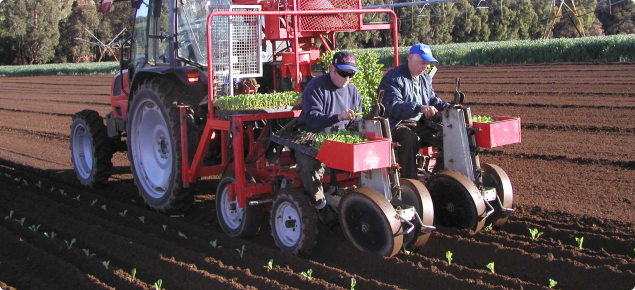Fertiliser is a major input cost in vegetable production along with labour and seedling costs. Optimising fertiliser rates and application methods is important to gain maximum benefit. The following information is based on trials carried out on broccoli and cauliflower crops grown in karri loams at Manjimup, about 300 kilometres south-west of Perth, Western Australia.
Phosphorus
Phosphorus is a key nutrient that needs to be carefully managed before planting in the loam soils around Manjimup. These soils retain, or fix, a large amount of phosphorus. After application, the phosphorus reacts chemically with iron and aluminium exposed at the surface of soil components (such as clays, oxides and organic matter) to form insoluble compounds that are less available to plants. Phosphorus must be applied in the soil pre-plant for it to be adequately available to a crop.
Cauliflower and broccoli plants require good phosphorus nutrition for adequate growth. Phosphorus is involved in processes such as cell division and providing energy for other chemical reactions. Phosphorus is needed early in a plant's life when the first cells for future roots, stems, leaves and flowers are produced and adequate supplies are required to achieve maximum potential yield.
Plant roots take up phosphorus from the soil solution as water-soluble phosphorus. It can only be taken up from moist soil. For all methods of application, using a fertiliser containing an increased concentration of water-soluble phosphorus will increase the amount of readily available phosphorus for plant uptake.
The amount of water-soluble phosphorus can be determined by looking at the chemical analysis of the fertiliser written on the bag or asking for the analysis if purchasing bulk supplies.
Fertiliser rates
Pre-plant fertiliser rate trials in Manjimup and a grower survey have found that many growers could potentially reduce their fertiliser rate without impacting on crop yield or quality. Trials found the optimum basal phosphorus rate for a cauliflower crop on loam soil was 100 to 120kg per hectare using the recommended strip incorporation application method but many growers are using 175 to 300kg of phosphorus.
Fertiliser needs vary from farm to farm and even paddock to paddock depending on cropping history, past fertiliser applications, soil type, crop management and post-planting fertiliser applications. To determine the right rate for your situation you can trial different rates in small strips to assess if basal fertiliser rates can be reduced without impacting on yield or quality.
Rate trials on cauliflowers conducted by the Department of Agriculture and Food involved three commercially available nitrogen, phosphorus and potassium (NPK) fertiliser products. Each product was applied at five rates ranging from 800 to 1600kg/ha. Each product contained between 7% and 12% phosphorus. For all three fertilisers the optimum rate to apply was 100 to 120kg/ha.
Applying higher rates did not produce a significant increase in either yield or curd quality. These fertiliser application rates are lower than commonly used in commercial practice.
If choosing a pre-mixed fertiliser product, always check the amount of each nutrient it contains. In the trial, regardless of which product was used, about the same amount of money was spent to apply the optimal phosphorus rates. Using a cheaper product necessitated applying it at a higher rate and so no savings were made.
A similar trial was conducted with broccoli but using only one basal fertiliser product. Based on the yield achieved and cost the most efficient rate of phosphorus to apply was 125kg/ha. Slightly higher yields were achieved with higher rates, however the small increase in yield did not provide enough return to cover the increased cost of fertiliser.
It might be expected that a broccoli crop would require less phosphorus than cauliflower, but a soil test for these trials showed a difference in soil phosphorus prior to planting. The broccoli site had 73mg/kg of phosphorus compared with 163mg/kg for the cauliflower site. This shows the potential impact of residual soil nutrient levels on fertiliser requirements.


